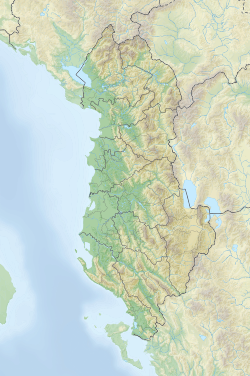Top Qs
Timeline
Chat
Perspective
Lead Mosque, Shkodër
Mosque in Shkodër City, Shkodër County, Albania From Wikipedia, the free encyclopedia
Remove ads
The Lead Mosque (Albanian: Xhamia e Plumbit), also known as the Mosque of Mehmet Bushati (Albanian: Xhamia e Mehmet Bushatit), is a mosque in Shkodër, northwestern Albania. The cupolas of the mosque were covered in lead; hence its name.[1] The mosque was designated as a Cultural Monument of Albania in 1948.
Remove ads
History
Summarize
Perspective
The Lead Mosque was built in 1773 CE by the Albanian pasha Mehmed Bushati of the noble Bushati family, who was vizier of Pashalik of Scutari at the time.[2] Through this act, he intended to give the feeling of the capital to his city of birth.[3] It is said that the mosque was built on land owned by the Catholic Church.[4]
Mehmed Bushati was involved with the construction and stones were incised under his patronage. Almost every day, he followed the progress of the works on site, leaving the Rozafa Castle, his residence.[1]
The first Imam of the mosque was Haxhi Ahmet Misria, who was of Egyptian origin. He came to Albania after the contacts he had with Mehmed Bushati. After him, other Imams served and also took care of the mosque.[1]
Damage

During the 1900s, the mosque was damaged and the lead that covered the cupolas was gradually stolen. In 1916, the remaining lead was removed by the Austrian army during the Austrian rule in Albania.[1]
In 1920, Xhelal Bushati, a descendant of Mehmed Bushati, reconstructed the mosque's minaret. The minaret was subsequently destroyed in 1967.[5] The same year, the mosque was closed, like the other religious institutions, after the anti-religious communist leader Enver Hoxha declared Albania an atheist state. Unlike many mosques that were destroyed during this time, the Lead Mosque survived, probably because it was designated as a Cultural Monument in 1948.[1][2][5]
On 16 November 1990, the Lead Mosque preceded other mosques in Albania to reopen when religion was again allowed in the country. The very first religious rally was held in this mosque by Hafiz Sabri Koçi, after 23 years of state atheism.[1]
Remove ads
Architecture
The Lead Mosque was completed in the Ottoman style, unlike most other mosques in Albania which follow Arab architecture.[2] The mosque closely mirrors the Classical Ottoman style of Istanbul, Turkey, pioneered by architect Mimar Sinan during the 16th century.[3]
The mosque is built with hewn stones of almost the same size, that created a construction symmetry. Stones were brought from the nearby village of Gur i Zi by people who aligned to each other over kilometers passing the stones to reach the construction point.[1]
Restoration
Flood damage in rainy seasons resulted in damage to the Lead Mosque over time.[6] The mosque was repaired numerous times: including in 1863, 1920 and 1963.[2] During 2021, the Albanian and Turkish governments completed the mosque's restoration.[6]
Remove ads
Gallery
- View to the restored mosque from Rozafa Castle
- South side of the mosque
- The mosque with its minaret until 1967
- View from Rozafa Castle
See also
References
External links
Wikiwand - on
Seamless Wikipedia browsing. On steroids.
Remove ads








